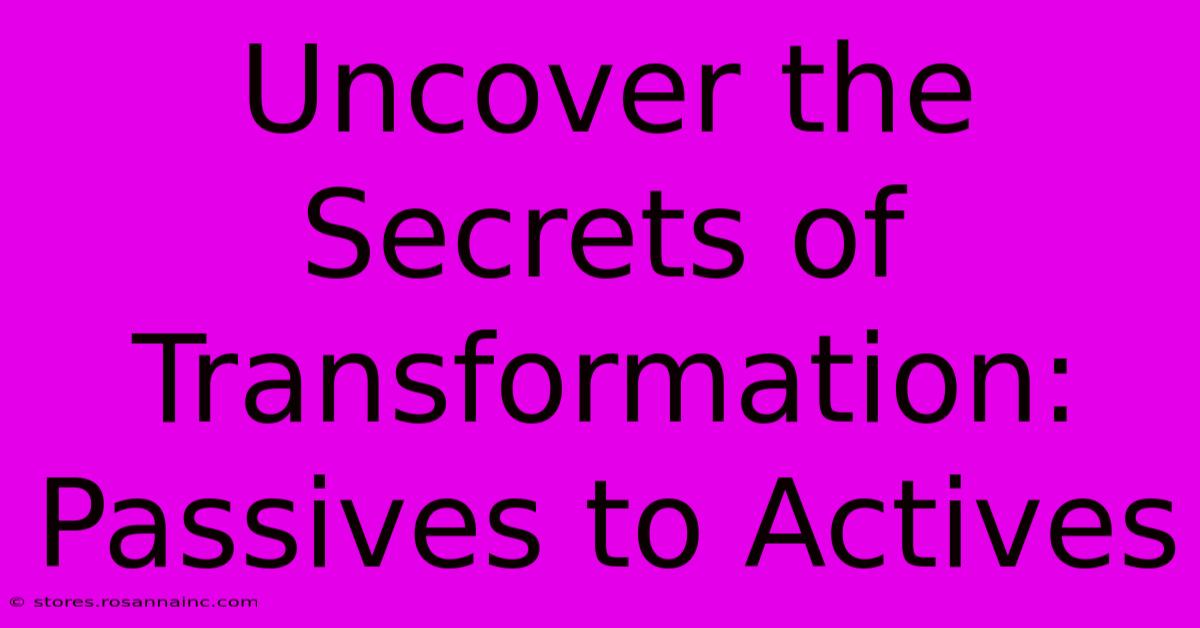Uncover The Secrets Of Transformation: Passives To Actives

Table of Contents
Uncover the Secrets of Transformation: Passives to Actives
Transforming passive sentences into active ones is a powerful technique to enhance your writing. It's not just about grammar; it's about clarity, conciseness, and impact. This guide will unveil the secrets behind this transformation, empowering you to write with greater precision and dynamism.
Why Switch from Passive to Active Voice?
The passive voice, while grammatically correct, often creates hazy and indirect prose. It obscures the actor performing the action, leading to weaker and less engaging writing. Active voice, on the other hand, is direct, clear, and dynamic. It immediately identifies the subject performing the verb, resulting in crisper, more impactful sentences.
Here's why you should prioritize active voice:
- Clarity: Active sentences are easier to understand. The subject and action are immediately apparent, eliminating ambiguity.
- Conciseness: Active sentences are often shorter and more to the point. They eliminate unnecessary words and phrases.
- Emphasis: Active voice emphasizes the actor, highlighting their role and responsibility.
- Stronger Tone: Active voice conveys a more confident and assertive tone, making your writing more persuasive.
Recognizing Passive Voice: Key Indicators
Identifying passive sentences is the first step to transformation. Look for these tell-tale signs:
- Form of the verb "to be" (is, am, are, was, were, been, being): Often combined with a past participle (-ed, -en, -t).
- Vague or absent subject: The actor performing the action is unclear or omitted altogether.
- Prepositional phrases: Phrases like "by someone" or "by something" often indicate a passive construction.
The Transformation Process: Passive to Active
Let's explore the mechanics of converting passive sentences into their active counterparts. The process involves identifying the subject, verb, and object, and then rearranging them to emphasize the actor.
Example:
Passive: The report was submitted by the committee.
Active: The committee submitted the report.
Steps for Transformation:
-
Identify the subject: In the passive sentence, the subject often receives the action. In our example, "the report" is the passive subject.
-
Find the actor (agent): This is often found in a prepositional phrase (e.g., "by the committee"). This becomes the subject of the active sentence.
-
Determine the verb: The passive verb is typically a form of "to be" plus a past participle. Identify the main verb (e.g., "submitted").
-
Rearrange the sentence: Place the actor (new subject) at the beginning, followed by the verb, and then the object (if any).
Exceptions to the Rule: When Passive Voice is Appropriate
While active voice should be your default, there are situations where passive voice might be preferable:
- Emphasis on the action, not the actor: When the action itself is more important than who performed it (e.g., "The window was broken").
- Unknown actor: If the actor is unknown or unimportant (e.g., "Mistakes were made").
- Formal writing: Passive voice can sometimes create a more formal and objective tone in certain contexts.
- Avoiding blame: Passive voice can be used to soften the impact of a statement (though this should be used judiciously).
Mastering the Art of Active Voice: Practice Makes Perfect
Transforming passive sentences into active ones requires practice. The more you practice, the more naturally you'll write in the active voice. Start by reviewing your own writing and identifying instances of passive voice. Then, challenge yourself to rewrite those sentences in the active voice. With consistent effort, you'll master this essential skill and significantly improve the clarity and impact of your writing. This leads to stronger communication, a more confident voice, and ultimately, more effective writing across all platforms.

Thank you for visiting our website wich cover about Uncover The Secrets Of Transformation: Passives To Actives. We hope the information provided has been useful to you. Feel free to contact us if you have any questions or need further assistance. See you next time and dont miss to bookmark.
Featured Posts
-
Unlock Your Career Potential Join The Elite Team At Perry Homes Today
Feb 04, 2025
-
Transform Wise Stamp With A Custom Font A Typographic Revolution
Feb 04, 2025
-
The Antidote To Contempt Cultivating Humility And Compassion Amidst Lifes Trials
Feb 04, 2025
-
Crystal Ball Clarity Predicting The Victor In Colorado State Vs Utep
Feb 04, 2025
-
Bokeh Heaven Viltrox Fe 20mm F2 8 Creates Dreamy Background Blur For Stunning Portraits
Feb 04, 2025
